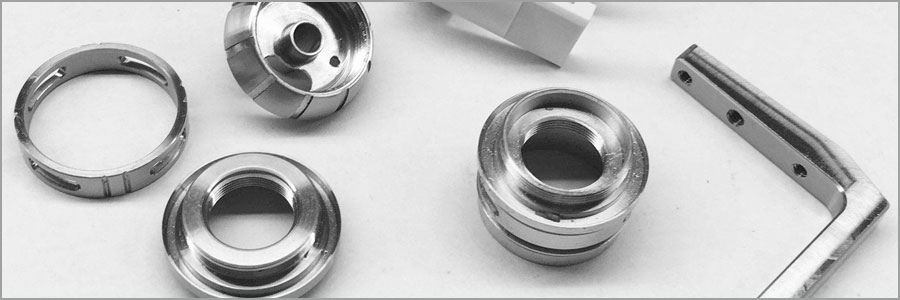What are the techniques for machining titanium parts? - PTJ Manufacturing Shop
Techniques for machining titanium parts
| Titanium alloy, a material commonly used in aviation and aerospace, is widely used in aerospace engines. Its density is generally 4.51g/cm3, which is about 60% of steel, but some high-strength. Titanium alloys exceed the strength of many high-strength alloy steels. Therefore, this material can produce rigid and lightweight parts. We often sit on airplanes, engines, skeletons, skins, fasteners and landing gear. Titanium alloys are generally used for manufacturing. |
 Many cnc machining manufacturers are at a loss when dealing with titanium alloys. In fact, titanium alloy processing is skillful.PTJ Precision Technology summarizes some titanium alloy processing techniques for everyone to share:
Many cnc machining manufacturers are at a loss when dealing with titanium alloys. In fact, titanium alloy processing is skillful.PTJ Precision Technology summarizes some titanium alloy processing techniques for everyone to share:
- Blades with positive-angle geometry to reduce cutting force, cutting heat and deformation of the workpiece.
- As far as possible in the softest state of titanium alloy, because the material becomes harder to process after hardening, heat treatment increases the strength of the material and increases the wear of the blade.
- The use of high pressure and large flow cutting fluid to ensure the thermal stability of the process, to prevent surface deformation and tool damage caused by excessive temperature.
- Maintain a constant feed to avoid hardening of the workpiece. The tool should always be in the feed state during the cutting process. The radial ae amount during milling should be 30% of the radius.
- Keep the blade edge sharp, blunt tool is the cause of heat build-up and wear, easily lead to tool failure.
-
Use a large tool nose arc radius or chamfer to cut in, and as many cutting edges as possible into the cutting. This can reduce the cutting force and heat at every point and prevent local damage. When milling titanium alloy, the cutting speed of each cutting parameter has the greatest influence on the tool life vc, and the radial cutting amount (milling depth) ae is second.
When the hardness of titanium alloy is greater than HB350, the cutting process is particularly difficult. When it is less than HB300, the sticking phenomenon is likely to occur and it is difficult to cut. Therefore, it is possible to solve the problem of titanium processing from the blade. The blade groove wear that occurs during the processing of titanium alloys is the local wear of the back and front in the direction of the cutting depth, which is often caused by the hardened layer left by the previous processing. The chemical reaction and diffusion of the tool and the workpiece material at a processing temperature exceeding 800 ° C is also one of the causes of groove wear. Because during the processing, the titanium molecules of the workpiece gather in the front area of the blade and "weld" to the blade at high pressure and high temperature to form a built-up edge. When the built-up edge is peeled off from the blade, the cemented carbide coating of the blade is carried away, so titanium alloy processing requires special blade material and geometry.
It is worth mentioning that because titanium alloys generate high heat during processing, a large amount of high-pressure cutting fluid must be sprayed onto the cutting edge in time to quickly remove heat. There is also a unique structure of milling cutters for titanium machining on the market, which is better suited for titanium machining.
It is worth mentioning that because titanium alloys generate high heat during processing, a large amount of high-pressure cutting fluid must be sprayed onto the cutting edge in time to quickly remove heat. There is also a unique structure of milling cutters for titanium machining on the market, which is better suited for titanium machining.
|
PTJ Machining Capabilities |
|
Automatic Bar Machining – Multi-spindle cam automatic screw machines CNC Turning – CNC delivers peak cost efficiency in shorter volumes, as well as high capacity production of mechanically simple components Custom Machining - with up to 12 axes of control Multi Spindle Machining- ISO 9001:2015 certified Screw Machine Products – The number of customized production parts per hour can reach 10000pcs Swiss Machining – with up to 9 axes of CNC control, to produce precision components with complex geometries in one operation High Volume Machining – 100 Advanced Production Turning Bar Automatics On-line and Ready CNC Milling - Machining Fully compliant with the exacting requirements of our customers 5 axis (11 axis) Machining – Tolerance | 0.1mm alignment |
What Can we help you do next?
∇ Get more information about Cnc Machining Shop
→Case study-Find out what we have done.
→Ralated tips about cnc machining services
By PTJ Manufacturing Shop|Categories: Blog|Tags: cnc milling services, cnc turning services, milling parts, turning parts, machining parts, special parts,faqs,technical news,company news,material news |Comments Off
